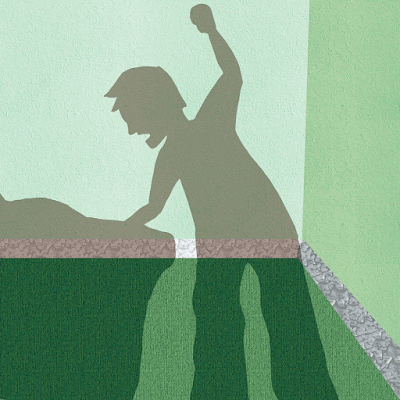This first illustration was inspired by the work of Gerald Scarfe[1], and his many illustrative interpretations on Margaret Thatcher. I wanted to replicate his flowing, expressive strokes and create a characterisation that has a strong silhouette. The joke works because although Thatcher had passed away in 2013, her spirit and legacy still lives on in politics today. Her infamous stances on political debates and Iron Lady status lent itself well to the line, 'I will never rust in peace!'.
This style is synonymous with the American political cartoonist, Monte Wolverton[2]. His way of cartooning includes a lot of different textures and cross hatching which creates an interesting shading gradient. I took the subject of Donald Trump running against Barack Obama in the upcoming presidential election. In Trump's US version of The Apprentice[3], his catchphrase for getting rid of a candidate in the running to win a partnership with him is, 'You're Fired!', which is the basis of the punch line here.
I wanted to try and do a comic strip for one of my examples, and so I took the newest budget reform and looked at a pros and cons list of what was happening with the newest changes. I saw that on the pros there was the fact the government was creating a scheme for helping people who have never owned a property get on the ladder by paying towards a deposit, but then on the cons there was extra pressure on landlords and so rent prices were going to increase. I saw this as an opportunity to set the scene with a couple and having a good news, bad news scenario. I used the style of Matthew Pritchett who does cartoons for The Telegraph[4]. On one interview, he says, 'I like my drawings to look like I've dashed them off'[5], which is why I kept my style quite sketchy and flowing. I also added very basic black and white shading, like he does in his cartoons.
I wanted to include a very recent part of political British history, and so I took the vote on the air strikes in Syria as my subject matter. After the voting had been resolved and it came to light that sixty-six of the Labour party had voted for the strikes, the current Labour leader Jeremy Corbyn announced that he would like to deselect them all and have the counties they represent re-elect an MP. I took inspiration from Steve Bell[6] and created a colourful piece with watercolour elements and harsh lines. I took the fact we're at the festive season as a muse for my joke, as I made Corbyn Santa Claus and included my personal MP for my borough Ian Austin (who voted for the air strikes) the child sat on his knee asking to keep his job, and Corbyn trying to buy his vote.
I started this project not knowing a lot about political cartooning and it's effect on history and the humorous way the cartoonists recorded it, but I now feel a lot more informed and like it makes politics more accessible for me as someone who doesn't really follow politics. This makes me respect their art form a lot more than I did before.
References -
[1] SCARFE, Gerald (2005). Drawing Blood: Forty Five Years of Scarfe. Little, Brown, New York City, US.
[2] Monte Wolverton. The Weekly Wolverton. [Online] Available at: http://www.wolvertoon.com/toons/ [Accessed on 6th December 2015].
[3] The Apprentice US (2006). Television Programme, Mark Burnett Productions, New York City, US.
[4] The Telegraph. Matt cartoons archive [Online]. Available at: http://www.telegraph.co.uk/news/matt/matt-archive/ [Accessed on 6th December 2015].
[5] The Telegraph (2013). Cartoonist Matt's typical day [Online]. Available at: https://www.youtube.com/watch?v=bouD1_HDomk [Accessed on 6th December 2015].
[6] BELL, Steve (2015). If: The Graphic Novel. Jonathan Cape Publishers, London, England.




















